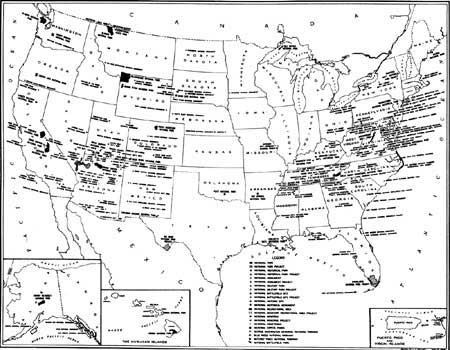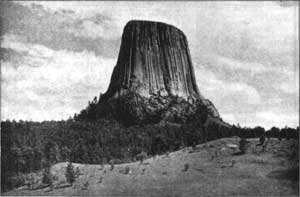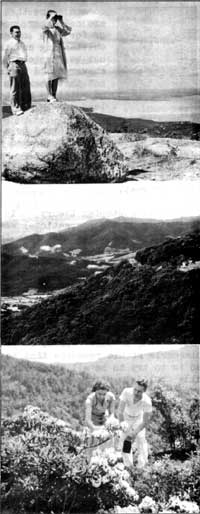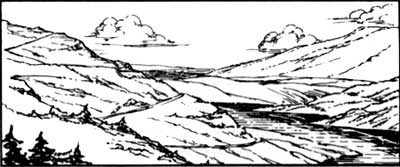AND NEW WORLD IDEALISM*
BY ARNO B. CAMMERER
Director,
National Park Service

Mr. Cammerer
|
The national park idea originated in the new world.
Many are familiar with the story of its origin, but for the benefit of
those who are not I want to give a brief review.
In 1870, an official party, known as the
Washburn-Langford-Doane expedition, went into the little known
headwaters of the Yellowstone River to make a reconnaissance of this
reputedly wonderful region and to verify or correct the unbelievable
stories that had been circulated for years about it. One evening after
several weeks of exploration during which the territory had been
thoroughly covered, the party was assembled around the campfire
discussing the wonders of the region. Different members were laying
claims to different regions of the Yellowstone and were making their
plans for the development of its resources for their own private profit.
One claimed a geyser basin, another claimed the Grand Canyon of the
Yellowstone, another one claimed the Mammoth Hot Springs, and so on.
Finally, one member of the party told the others that he thought they
should look beyond their plans for private exploitation of the
Yellowstone; he suggested that, instead of apportioning the region
piecemeal for private benefit of the party members, the group should
unite in an effort to have the area set aside for the benefit and
enjoyment of all the people, to be protected for all time as a national
park. The idea was accepted immediately and discussed long into the
night. When their trip was over they dedicated themselves to the
Yellowstone National Park idea with such effectiveness that the park was
established by Act of Congress in 1872.

NATIONAL PARK SYSTEM AREAS AND PROJECTS
(click on image for an enlargement in a new window)
Yellowstone was the first national park. Since then
the idea has gone around the world. Soon after the establishment of the
Yellowstone the demand for preservation and public use of other great
scenic areas became widespread. By 1880, Senator Miller of California
had introduced a bill to establish a national park in the southern
Sierra to include Kings Canyon and the great sequoia forests. Ten years
later small portions of that region were withdrawn from the possibility
of private exploitation and set apart as the Sequoia and General Grant
National Parks, and, in the same year, the Yosemite became a national
park; but it was not for sixty years that Kings Canyon itself was given
that status.

Devils Tower, Wyoming, First National Monument
|
In 1906 a new step in the national park program came
about through enactment of what is called the Antiquities Act. Congress
then established the principle not only that all archeological material
on the public lands is public property and cannot be removed without
permission of the Government, but also that objects of historic,
prehistoric, and scientific interest that are situated on the public
lands may be set apart by proclamation of the President as national
monuments to be conserved for public benefit. The first national
monument established under the authority of the Antiquities Act was a
famous western landmark, the Devils Tower in Wyoming, a spectacular
volcanic core rising some 800 feet above the surrounding plains (See
opposite page). Thus, the first national monument was an object of
scientific interest.
Several areas of archeological and biological
interest soon were established as national monuments. These early
monuments were important steps in developing the principle that objects
and sites of prehistoric, historic and scientific interest, situated on
the public lands, are important public resources worthy of preservation
for public use.
Congress established the National Park Service in
1916. Before that time there had been no bureau whose sole function it
was to further the national park interests. Its purpose was defined:
The service thus established shall promote and
regulate the use of the Federal areas known as national parks,
monuments, and reservations hereinafter specified by such means and
measures as conform to the fundamental purpose of the said parks,
monuments, and reservations, which purpose is to conserve the scenery
and the natural and historic objects and the wild life therein and to
provide for the enjoyment of the same in such manner and by such means
as will leave them unimpaired for the enjoyment of future
generations.
At that time, the national park and monument system
already included many different types of areas but no one agency was
responsible for integration of the program. Some of the national
monuments were administered by the Department of Agriculture. A large
number of historic sites, parks, and memorials were administered by the
War Department. In 1933, all of the national parks, monuments and
related historic reservations administered by the Federal Government
were made the responsibility of the National Park Service.
A further growth in the national park program found
expression in 1935 in the Historic Sites Act, in which Congress declared
it "a national policy to preserve for public use historic sites,
buildings and objects of national significance for the inspiration and
benefit of the people . . ." The act carried practical provisions
empowering the Secretary of the Interior to cooperate with numerous
types of agencies in protection and maintenance of outstanding historic
sites, buildings, and objects.
A significant step toward a more coherent and
integrated national recreational program was made in 1936 with passage
of the Recreational Study Act, which authorizes the Secretary of the
Interior, through the National Park Service and in cooperation with
other federal agencies and with the several states, to conduct a study
of the park, parkway and recreational-area programs of the country, in
order to develop a coordinated national recreational program. The study
is being conducted and many of the states already have transmitted
reports.
The national park system is composed today of 158
historic and natural areas, with a total of 21,515,000 acres. Regardless
of the different types of parks and monuments in the national park
system, there are certain general policies and practices that apply to
all:
They are administered primarily for the benefit and
enjoyment of the people. Nature is preserved and not improved.
They are game sanctuaries and not hunting
reservations.
No commercial enterprise is permitted except so far
as is essential for the care and comfort of park visitors, and in those
few exceptions specifically directed by Congress.
The national interest is supreme and encroachment for
private benefit is resisted.
They are developed in accordance with officially
approved master plans. Such plans are the product of the entire Service
and reflect the best judgment of the administrative officers and their
technical advisors. It is the purpose of such developments to give
public access to the main features of the areas but to preserve the
greater portion of each area without encroachment.
To meet the needs of park visitors, the Service has
followed the general policy of providing a graded scale of
accommodations, ranging from free campgrounds, provided by the
government, to cabins, lodges, and hotels provided by the park
operators. The Service attempts to provide facilities that will meet the
financial requirements of every visitor.

Having presented this brief review of the origin and
growth of the national park system, I should like to discuss it as a
form of land use in a general conservation program. Parks are an
expression of maturity and restraint. They are an indication that people
have begun to look outward and to see with perspective. With that
perspective, it is seen that in our struggle for existence we can afford
to preserve some of the native beauty of our land and to use it. The
park concept is clearly the product of a balanced mind -- a mind that
sees in a waterfall something more than potential horsepower, that sees
in a giant forest something more than lumber, or that sees in a
flowering mountain meadow something more than a sheep pasture, and,
having seen, does not desire to exploit it for private gain.
The national park idea is a consistent part of New
World Idealism. Its development need not be limited except by our vision
and our generosity. If we are far-seeing enough, park benefits can
become an international heritage of the Americas. The native beauty of
the land and the homespun cultural fabrics of each different country can
become common heritage. The nature reservations and historic shrines of
all the American countries can be united, not only by international
parkways and peace parks, but likewise by the international language of
the park idea, until there is a Pan-American Park System covering the
continents from southern Chile and Argentina to Alaska and Canada.
Nature has given us the snowclad cordilleras
reaching from Mount McKinley to Nahuel Huapi, the white line of breakers
that rims the Americas, clean rivers, forests and plains teeming with
wildlife, the fertile soil, and other resources in great abundance. Over
it all, and made of it, is the scenic mantle, the element of natural
beauty, which was not recognized as being a resource by the pioneers but
which has come to be recognized as one of the indispensable resources of
our civilization. This scenic and recreational mantle of the Americas is
wearing then; moths, fire and acids have eaten it full of holes and in
many places it is little more than the tattered shreds of a shawl. We
should be wise to protect and restore it. This resource is indispensable
because it is the re-creative resource, and recreation is essential to
life.
The recreational resource is not something that
stands apart from the other resources; it is composed of them and is
usually the total of them all. When it is conserved and utilized
properly, there is strong probability that all the component resources
are treated properly. Likewise, when the component resources have been
squandered, the recreational resource has vanished. Recreational utility
is rightly becoming the criterion of good land management, and parks are
strongly indicated as the apex of a national conservation program.
Parks are not a type of scenery; they are a type of
public reservation. That type of reservation could be applied to an acre
of grassland in the plains as well as to an acre of mountain summit in
the Andes or the Rockies. Park standards refer therefore, not to the
kind of natural scenery that may be selected f or park status, but to
the use that is made of it. Here in the United States there has been
hair-splitting difference of opinion for many years over the question of
park status for this mountain peak or that one, because some other one,
already established as a national park, is a little higher or may be
resembled superficially by the peak that is being recommended for park
status. Impractical as such dialectic is, famous scenic areas have been
opposed for national park status for years on that basis. If there were
two Yellowstones, should we refuse to use one of them?
|
A POLICY AND A CHALLENGE
Park Conservation is a national policy and a national
challenge.
Since its beginning, the defenders of the national
park and monument system have been pioneers in a new and civilized form
of land use. They have distilled from the rough and ready methods of
wilderness conquest new techniques and practices, so that park
conservation is no longer merely a principle of good stewardship but is
a definite function of government with scientific application. They have
found ways of using the native beauty and the native-spun character of
our country in such manner that they shall not be destroyed but shall
contribute to our national fabric.
Parks are as much a form of land settlement as are
farms, and park management is as much a land settlement industry as is
the growing of corn, potatoes, or wheat. In the settlement of a country
some lands are suited to farming, others to grazing, others to forestry
and mining. But some lands are more suitable for the inspiration, or
recreation, of the people---breathing spaces, they might be called. The
important problems for the parkman are to determine which lands are best
adapted to serve as parks and how best to use them.
From What Are National Parks?, Supplement to
Planning and Civic Comment, Vol. IV, No. 1.
|
Park reservation is equally applicable to the lofty
mountains, the great plains, the southern coastal forests, the deserts,
or the seashore. No matter what type of physiography may be chosen, or
what biologic, geologic, historic, or archeologic exhibit, the purposes
are the same: the areas are set apart to be preserved and enjoyed
without impairment. While the 158 reservations in the national park
system are grouped into 11 descriptive categories---such as parks,
monuments, historical parks, historic sites, battlefield parks,
memorials, etc.---they are all the same type of reservation. Generically
all are parks.
When someone attempts to break through one of these
reservations and exploit its resources for private gain, that is a
threat to park standards and should be a matter of public concern. Such
attempts usually are piecemeal, and each is made by its proponents to
appear reasonably insignificant. But the parkman knows from hard
experience that all such invasions are cumulative, and that the toxin,
if permitted, will in time become lethal.
In the national parks we are trying to preserve the
land whole, not that human use of the areas should be subordinated to
nature protection, and not that in the parks we think more of wildlife
or other objects than of people. Parks are for the people to use and
there is no other reason for their existence. But, if a car is to
transport us, we must keep its mechanism in running order. If parks are
to serve us we must protect their natural machinery. There is a keen
analysis of the point in Grinnell's and Storer's Animal Life in the
Yosemite in which they describe how a segment of nature works.
"The White-headed Woodpecker," they point out, "is a
species which does practically all of its foraging on trees which are
living, gleaning from them a variety of bark-inhabiting insects. But the
White-headed Woodpecker lacks an effective equipment for digging into
hard wood. It must have dead and decaying tree trunks in
which to excavate its nesting holes. If, by any means, the standing
dead trees in the forests were all removed at one time, the
White-headed Woodpecker could not continue to exist past the present
generation, because no broods could be reared according to the inherent
habits and structural limitations of the species. Within a woodpecker
generation, the forests would be deprived of the beneficent presence of
this bird. The same, we believe, is true of certain nuthatches and of
the chickadees--industrious gleaners of insect life from living trees.
They must have dead tree trunks in which to establish nesting and
roosting places, safe for and accessible to birds of their limited
powers of construction and defense . . . Dead trees are in many respects
as useful in the plan of nature as living ones, and should be just as
rigorously conserved."

The type of facts that Grinnell and Storer point out
is no hindrance to park management and use. Recognizing these facts in
our plans and developments, we can increase the utility of our parks,
and if our feet are on the ground, we can develop almost any kind of
park. To do so, however, our purposes must be clearly in mind. These
statements seem obvious, but in fact they are not. There is frequent
conflict between parkmen, one faction charging that the other would lock
up the parks and keep people out of them, the other asserting that the
first would make city playgrounds of all parks. Would not both factions
be nearer the truth if they agreed that there is no conflict---that we
should, so to speak, render to Caesar the things that are Caesar's and
to God the things that are God's? That we should not try to treat Jones
Beach as we would the back country of Yellowstone or make Yellowstone
serve as Jones Beach? Countless thousands may play on the beach and the
tide comes and washes their tracks away. Countless thousands trampling
the roots and packing the soil around a giant Sequoia tree will kill the
tree that they come to see. Both the wilderness park and the heavily
used beach have their places, and there is no legitimate conflict
between them. Management of any park must partake of common sense and
good taste so that development will not defeat the purpose for which it
was established and that purpose will not be confused with the purpose
of some other park.

At top, Frenchman Bay, Acadia National Park Maine;
middle, view north from Skyland, Shenandoah National Park, Virginia;
bottom, rhododendron in Great Smoky Mountains National Park,
North Carolina-Tennessee.
|
Park management is more, of course, than common sense
and good taste. It is a profession and a career in actuality, and the
time is ripe for its techniques to be professionalized academically. The
breadth of its activities, its intense absorption with people and
nature, its concern with the physical evidences of history and
prehistory, their preservation and interpretation, the host of practical
skills required in construction, operation and maintenance and the
ever-guiding objective of preserving the best and making it
available--all these make the park profession one of the most attractive
and stimulating of all careers.
How many parks can we afford? How many acres are
required? When will the saturation point be reached? The answer to these
questions is expected to be given in quantitative terms; but recreation
cannot be measured quantitatively because it is a quality of living. Who
can say when our living is good enough? Yet I have seen statements that
the present acreage of parks is all that the country will ever need. The
only honest answer to these questions is, I believe, that the struggle
to improve our living is a never-ending one, and that so long as any
cultural and recreative factor in our historical and natural resources
is being needlessly destroyed it is a challenge. Park status in such
cases may be a more useful and productive status than any other, and
present indications are that we can afford to live more generously than
we have realized.
G. A. Pearson, in the Journal of
Forestry,1 says: "Foresters no longer believe that every
acre of land that can be made to grow timber must be used for that
purpose. One hundred million acres of productive and well located
timberlands could be made to produce annual yields far exceeding present
consumption in this country. Additional areas to the extent of perhaps
300 million acres might well be kept in some sort of forest in the
interest of recreation and watershed protection, and to provide a
reserve acreage for timber production."

If lands are no longer good for one use, it seems
only common sense that we put them to another use. If lands are no
longer needed for growing timber, for instance, or for some other
industrial purpose, and they are of outstanding scenic and recreational
character, would it not be simple wisdom to reserve them for recreation?
The answer would be in the affirmative more often if it were not that
there is a widespread tendency to try to do too many things for too many
people on every acre of public land.
This policy is referred to as a multiple use. Under
it we are told that the resources of a proposed park are so intertwined
and are of such great importance that the only way the area can be
properly managed is to use all the resources simultaneously and equally,
and, that if this is done, the recreational resource will receive full
consideration along with the rest.
It is a Utopian theory. In the first place, it does
not recognize the nature of the recreational resource which, as has been
said already, consists of the other resources in combination. As much as
you take from each of the component resources, by so much do you take
from it. As numerous writers have pointed out, this system of
management, failing to recognize the dominant resource of a given area,
detracts from its value by giving equal place to subordinate resources.
This is apt to be little more than multiple abuse.

Of what virtue is it to advocate multiple use of a
watershed that is worth a thousand dollars an acre for water catchment
purposes? By the same token, of what virtue is it to advocate multiple
use of an irreplaceable scenic resource that is of public inspirational
value? To do so is to try to be all things to all people. It is to
reduce land planning to local political pulling and hauling. It is the
absence of planning. It would not be worth recognizing except that it is
so widely accepted that it has become one of the greatest obstacles to
sound land classification.
Multiple use is a common, and often a good, feature
of land management. As it is commonly accepted, however, it means the
specific brand of land management that I have described, which sets
multiplicity as its objective and permits a mediocre rating of every
resource in a given area.
Mr. Pearson, in the article already mentioned
says:
The land management plan envisioned in this article
conveys two conceptions of multiple use. In one, management is by units
in each of which one use is dominant though not exclusive; in the other,
all uses are accorded equal rank on the same area . . . The second plan
is applicable, theoretically, where all factors are under complete
control; but, because this situation can rarely be attained, the plan is
adapted mainly to lands on which all uses are so low that priorities
have no practical significance. Forest lands, both public and private,
are now being handled, with minor exceptions, according to the second
plan. In order to realize the highest values the trend must be more and
more toward the first . . .

Perry's Victory and International
Peace Memorial National Monument, Ohio.
|
Siegfried von Ciriacy-Wantrup, writing in the same
journal, said:
"Under the concept of optimum use there may be
several uses. The idea, however, is not to have several uses always but
to permit them if they are socially desirable. In many cases the optimum
use will be a single use rather than some combination of several uses.
In other cases it will be one dominant use and as many subordinate uses
as do not interfere with the dominant use. In a few cases there may be
two or more codominant uses of nearly equal importance."2
Nobody could have any quarrel with multiple use as a
descriptive term, provided it is only an incidental aspect of optimum
use. A national park, for instance, which the multiple use exponents
usually refer to as a single use form of land management, actually may
provide several uses. It may provide vital watershed protection; serve
as a wildlife sanctuary, as a natural and historic museum and place of
public education; it may serve as a source of employment for local labor
and a market for local products; increase the value of adjacent and
tributary property, and, at the same time, serve as a stimulus to
national and international travel, which in turn stimulates a host of
other industries. All these are incidental to the dominant use of the
land for recreation. In such case, the optimum use of the land includes
several uses, but multiplicity is not the objective: it is an
incidental, and even accidental, aspect.
I sincerely believe that the exponents of multiple
use really have optimum use in mind, and that they have no thought but
that the natural resources should be appraised with intelligent
selectivity. If that is the case, then we should recognize it by all
means and admit that we do not hold multiple use either as a formula of
land management or as an objective. Such action would revolutionize
public land management. It would lead to the classification of lands
according to their best uses. It would mean, for example, as Pearson
says, that "Livestock production like timber production would profit
immensely, if instead of trying to utilize all lands regardless of
quality, the range industry were concentrated on lands really suited to
it by climate, soil,and water facilities." It would mean that a national
conservation program, insofar as the public lands are concerned, would
be rational and flexible and that recreational lands would be classified
as recreational lands rather than as forest or range or some other
category for which they are largely useless. It would mean, in time,
that lands classified according to their dominant use would be managed
by agencies especially skilled in providing those uses, and that
incidental uses would be permitted in accordance with their relative
importance.
In such a conservation program there might be more
parks or there might not be, depending upon the classification of the
resources. It might be found that recreational areas, so classified for
their dominant use but subject to certain subordinate uses, would be a
useful complement to the park systems. Such areas would be more apt to
retain their distinguishing characteristics, and to render their maximum
usefulness, if they were so recognized, but parks would remain the apex
of the conservation program because they are the irreducible
treasures.
* From an address given May 13, 1940, before the
Eighth American Scientific Congress, Washington, D. C.
(1) "Forest Land Use." Vol. 38, No. 3, March 1940,
pp. 261-270.
(2) "Multiple and Optimum Use of Wild Land under
Different Economic Conditions." Journal of Forestry, Vol. 36, No.
7, July, 1938, pp. 665-674.

|
SUMMARY OF SERVICE AREAS
as of June 20, 1940
| Type of Area | Number |
Sq. Miles | Acres |
|
| National Parks | 26 | 16,109.91 | 10,310,339.80 |
| Historical Parks | 4 | 11.97 | 7,658.27 |
| National Monuments | 82 | 14,764.40 | 9,449,214.35 |
| National Military Parks | 11 | 32.70 | 20,921.48 |
| National Battlefield Parks | 2 | 4.97 | 3,181.00 |
| National Battlefield Sites | 6 | 0.23 | 150.16 |
| National Historic Sites | 4 | 0.35 | 223.59 |
| National Recreational Area | 1 | 2,655.58 | 1,699,573.00 |
| National Memorials | 8 | .50 | 317.11 |
| National Cemeteries | 11 | .55 | 353.46 |
| National Capital Parks | 1 | 16.88 | 10,803.16 |
| National Parkways | 3 | 51.95 | 33,245.15 |
Totals |
159 |
33,649.99 |
21,535,981.46 |
|
|

